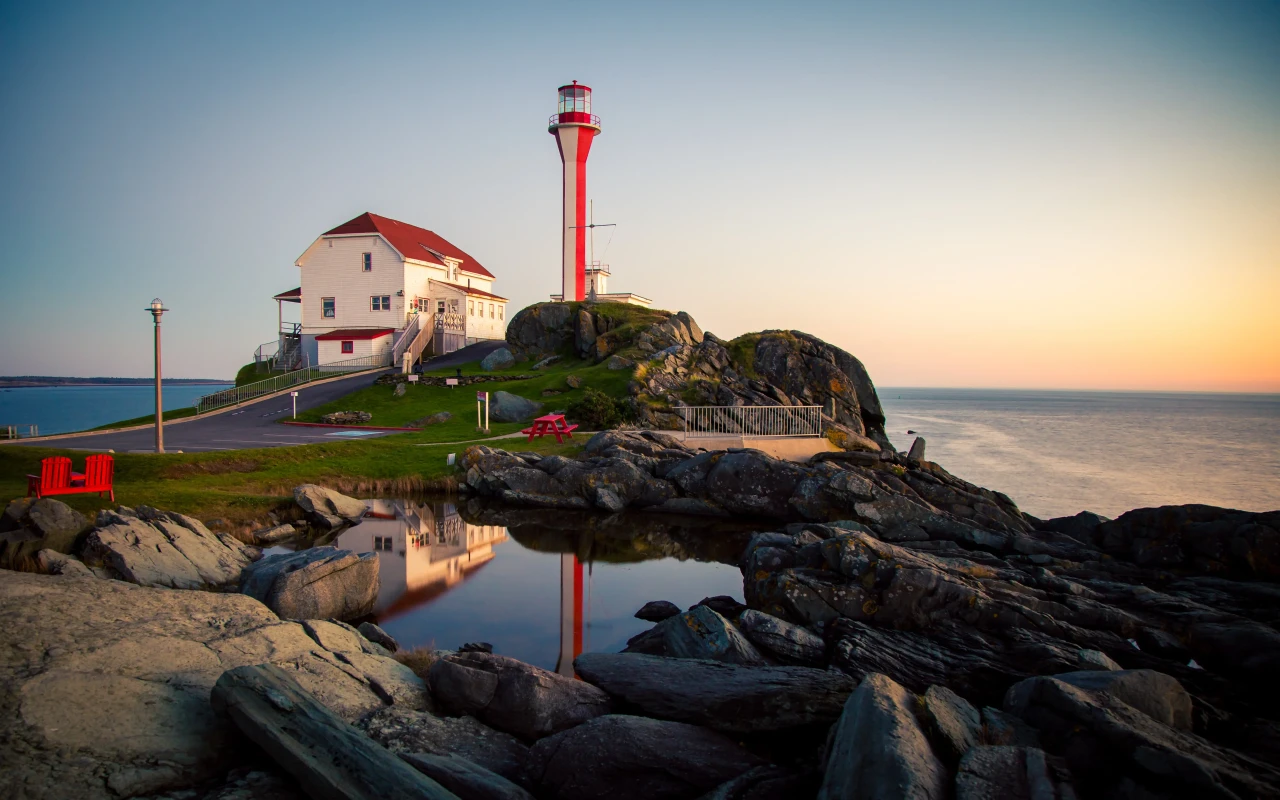Claim to Fame
Cape Forchu Lighthouse is one of Canada’s most photographed coastlines, famed for its “Leaning X” modernist tower beside the historic foghorn building and panoramic views of the Atlantic.
📌 Navigating Cape Forchu Lighthouse : Answers to Frequently Asked Questions
- Washrooms: Public restrooms are available for visitors.
- Hours of Operation: The lighthouse is typically open to the public during daylight hours.
- Important Information: Check for any special events or accessibility details before visiting.
- Admission Fee: No admission fee is required to visit the lighthouse grounds.
- How Long to Visit: Visitors often spend 1-2 hours at the site, enjoying the views and exploring the surroundings.
- Parking: Parking is available at the lighthouse.
- Family Friendly: The site is family-friendly, with outdoor spaces for children to explore.
- Photography: Photography is a popular activity here, with stunning ocean views and the picturesque lighthouse.
- WIFI: No WIFI is available at the lighthouse.
- Picnic Area: Picnic areas are available for those who prefer to bring their own food.
- Handicap Accessible: The grounds are accessible, but access to the lighthouse itself may be limited for those with mobility issues.
- Pets: Pets are allowed on the grounds but must be kept on a leash.
- Guided Tours: Guided tours may be available; check in advance for schedules.
- Restaurant or Cafe: There's a café or small restaurant on-site or nearby, offering local dishes and refreshments.
- Gift Shop: A gift shop is available, offering souvenirs, local crafts, and maritime-themed items.
Photos of Cape Forchu Lighthouse
Perched on a rugged headland at the mouth of Yarmouth Harbour, the Cape Forchu Lighthouse has guided mariners since 1839. Its distinctive “old light” stone tower stands alongside the 2016 “Big Light” – a striking modern reinforced concrete design by Cape Breton architect Gerald Brouse. A segment of the scenic Lighthouse Route, the site offers dramatic cliffside trails, interpretive exhibits on maritime history, and sweeping ocean vistas that capture the wild beauty of Nova Scotia’s southwest coast.
What to Expect
At the Visitor Centre you’ll find exhibits on shipwrecks, sailor lore, and local Acadian fishing heritage. Follow the 1.5-kilometre Coastal Trail, which loops around the headland past interpretive panels and lookout platforms. On clear days, you can spot seals, seabirds, and distant fishing boats navigating the Atlantic swell.
The lens gallery in the restored original lighthouse displays Fresnel lenses and navigation instruments. Nearby picnic tables overlook natural tide pools where starfish and crabs gather. Guided “Keeper’s Tours” in summer offer behind-the-scenes access to the old light’s lantern room and stories of the 1918 “Yarmouth Gales,” which battered these very cliffs.
Background and Cultural Context
The first lighthouse at Cape Forchu was built of masonry in 1839, replaced in 1884 by the current stone tower. In 1962, an automated beacon rendered it obsolete until community efforts preserved the old light as a museum. The new “Big Light” was erected in 2016 to modern standards, its angular silhouette echoing the Coast Guard’s searchlights and Nova Scotia’s maritime innovation.
Yarmouth’s economy has long depended on shipbuilding and fishing; Cape Forchu marked the entrance to one of the province’s busiest 19th-century ports. Annual “Lobster Suppers” and local folklore celebrate this seafaring heritage, while the site’s conservation plan balances visitor access with protection of fragile coastal vegetation and nesting birds.
Best Time to Visit
Late spring (May–June) delivers wild lupines along the trail and migrating seabirds. Summer (July–August) offers the warmest weather and full guided-tour schedules. Autumn (September–October) brings dramatic storms and fall colours against grey granite. Aim for early morning (8–10 AM) or late afternoon (4–6 PM) to avoid crowds and catch golden-hour light on the cliffs.
How to Get There
Cape Forchu lies 8 km south of Yarmouth via Route 330 (Lighthouse Route). Follow signage to the Visitor Centre, where ample paid parking is available. From Yarmouth ferry terminal, it’s a 15-minute drive; some summer tours include shuttle service from town. Limited roadside parking exists near the trailhead for cyclists.
Photo Opportunities
- Sunrise behind the “Big Light” concrete tower framing the Atlantic horizon
- Historic stone tower and foghorn building reflected in tide pools at low tide
- Coastal Trail lookout capturing swooping seabirds and crashing waves
- Trailside wildflowers and lupines contrasted against weathered granite outcrops
- Stormy skies illuminated behind the lighthouse during autumn gales
Travel Tips
- Wear sturdy, non-slip footwear for uneven granite paths and reef ledges.
- Bring windproof layers and waterproof gear—Atlantic breezes and spray are constant.
- Carry water and snacks; the Visitor Centre café offers light refreshments but closes by late afternoon.
- Plan 1–2 hours to hike the Coastal Trail, tour both lighthouses, and visit the exhibits.
- Respect wildlife—keep a safe distance from nesting seabirds and avoid trampling fragile dune grasses.
FAQs
Can I climb the old lighthouse?
Yes—guided Keeper’s Tours include a climb to the lantern room; unescorted access is not permitted for safety reasons.
Is the “Big Light” open to visitors?
No—the modern concrete tower is not open inside, but its base pavilion features interpretive panels viewable through large windows.
Are dogs allowed?
Leashed dogs are welcome on the Coastal Trail but not inside the Visitor Centre or old lighthouse museum.
Is there an admission fee?
Yes—Adults CAD 10; Seniors/Students CAD 8; Youth (6–17) CAD 5; Children under 6 free; family passes available at a discount.
Final Thoughts
Cape Forchu Lighthouse blends historic charm with contemporary design against a backdrop of relentless Atlantic seas. Its coastal trails, maritime exhibits, and iconic architecture make it a must-visit destination for photographers, history enthusiasts, and anyone drawn to Nova Scotia’s rugged seaside beauty.
